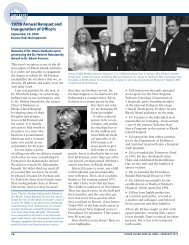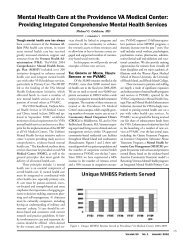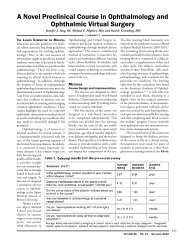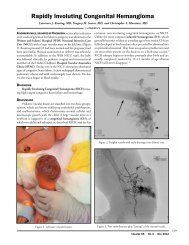The Providence VA Medical Center - Rhode Island Medical Society
The Providence VA Medical Center - Rhode Island Medical Society
The Providence VA Medical Center - Rhode Island Medical Society
- No tags were found...
Create successful ePaper yourself
Turn your PDF publications into a flip-book with our unique Google optimized e-Paper software.
18greater risk for TBI than others), variabilityin TBI experience of cliniciansperforming the evaluations, and the institutionallearning curve given the factthat the process was introduced relativelyrecently.<strong>Providence</strong> <strong>VA</strong>MC Experience:Through May 31, 2009, theP<strong>VA</strong>MC has screened 1672 veteranswith the Clinical Reminder; of these, 262(15.7%) have screened “positive.” Ofthese positive screens, 184 have completedthe Comprehensive Second-LevelEvaluation, which confirmed the mTBIdiagnosis in 120 (65%).Our Polytrauma Team functions asa PSCT (official designation by VHA ispending). <strong>The</strong> team is led by a neurologistspecializing in neurorehabilitation/TBI and includes a social worker/casemanager, neuropsychologist, primarycare physician, and a psychologist specializingin PTSD, as well as a physicaltherapist, occupational therapist, speechtherapist, ENT nurse practitioner, andhearing and vision specialists. Other disciplinesare consulted as needed. <strong>The</strong>team meets weekly to review veteransnew to the Polytrauma Team and to provideperiodic review of established patients.A weekly Polytrauma intake clinic(neurologist, neuropsychologist, socialworker/case manager) screens newly referredveterans to identify ongoing problemsand develop a treatment plan. Inaddition, the neurologist and case managerhave a weekly Polytrauma/TBI follow-upclinic in which veterans with ongoingmedical and psychosocial problemsare seen as needed. <strong>The</strong> majority of patientsseen by our team likely sustainedmTBI during their OEF/OIF deploymentwithout concomitant severe somaticinjuries.MEDICINE & HEALTH/RHODE ISLANDSYMPTOM MANAGEMENT<strong>The</strong> most common complaints ofpatients in the Polytrauma Clinic includepain (mostly headaches and back pain),dizziness, hearing loss/tinnitus, sleep difficulty,anxiety and symptoms of PTSD,and cognitive complaints such as forgetfulnessand diminished concentration.As there is no “specific” treatmentfor cognitive complaints in mTBI, emphasisis placed on identifying and treatingmodifiable factors such as PTSD,depression, substance abuse, sleep deprivation,pain, and other factors such asloss of employment and marital distress,that might be contributing to veterans’symptoms and which, if adequatelytreated or addressed, could have a positiveimpact on their quality of life. <strong>The</strong>Polytrauma Team makes referrals to specialistsand <strong>VA</strong> programs as needed andpromotes veterans’ compliance with treatmentplans. <strong>The</strong> most common referralsare to the P<strong>VA</strong>MC Mental Health andBehavioral Science Service, particularlyto the PTSD Clinic, the Returning VeteransProgram, the Substance AbuseTreatment Program, and to the NeuropsychologyClinic. Referrals to Physical<strong>The</strong>rapy and Speech and Language Pathologyservices (the latter for cognitiveretraining) are also common. <strong>The</strong>Polytrauma Team emphasizes educatingpatients and their families about the expectedtrajectory of recovery from mTBIand the possible treatable factors. Suchinterventions have been shown to reducethe likelihood of patients with mTBI developingpersistent postconcussion syndrome.17,18As of the firstquarter of 2009approximately102,000 of OEF/OIF veterans havebeen diagnosedwith PTSD.MILD TBI: CONTROVERSIESHoge et al 19 raise several concernsabout the DOD/<strong>VA</strong> process for diagnosisand management of mTBI. First,they postulate that the screening processrisks incorrect attribution of nonspecificsymptoms to mTBI. Second,they suggest that disability may be overlyattributed to mTBI, and they raise thepossibility that “post-deployment screeningis…likely to promote negative expectationsfor recovery.” <strong>The</strong>y also assertthat misattribution of symptoms tomTBI potentially places veterans at riskof negative consequences, includingmedication adverse effects, failure toadequately address concurrent conditions(e.g., depression, PTSD, substanceabuse, etc.), and inappropriate use ofrehabilitation procedures. <strong>The</strong>y suggestdevelopment of improved definitionsand diagnostic criteria and processes.<strong>The</strong> VHA’s standardized team approachaims to minimize over-diagnosisand misattribution errors via thoroughSecond-Level Evaluations that assess forco-existing conditions that may be contributingto symptoms and addressingthem appropriately. Many believe thatthe benefit derived from the thoroughnessof this process in identifying andaddressing previously untreated symptomsoutweighs the risk of over- diagnosis,and that when managed by trainedphysicians and ancillary providers, therisk of negative consequences is minimal,if present at all. Finally, the data to designimproved diagnostic criteria are notyet available.CONCLUSIONSVeterans of conflicts occurring overthe last nineteen years often have complex,multisystem injuries, and a largenumber are being diagnosed with mildTBI with significant comorbidities includingPTSD and somatic injuries,particularly auditory/vestibular injuries.<strong>The</strong> Polytrauma System of Care is designedto standardize the diagnosis andmanagement of these conditions nationwide.Although making the diagnosis ofmTBI requires ongoing assessment, ourexperience at P<strong>VA</strong>MC has been that thePolytrauma Team has been effective inbringing veterans with multiple injuriesand/or medical conditions into thehealth care system, helping them accessthe care they need, and monitoring theirprogress.ACKNOWLEDGMENTS<strong>The</strong> authors thank David Chandler,PhD, Deputy Chief Consultant, RehabilitationServices, VHA, for his helpfulcomments on this manuscript. This materialis based upon work supported bythe Office of Research and DevleopmentRehabilitation R&D Service, Departmentof Veterans Affairs. <strong>The</strong> contentsof this manuscript do not represent theviews of the Department of Veterans Affairsor the United States.
















